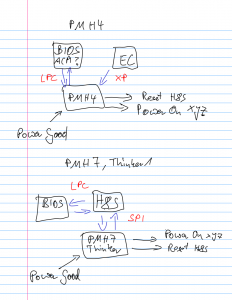Hello! I have been away for some time now, so this is going to be a longer post. I hope you have missed hearing from me 😛 In this post I will talk about my work in the weeks post-midterm evaluations. After a discussion with my mentors in the midterm evaluations week, we decided to shift focus towards the first three phases of my GSoC proposal for the remainder of the duration. Work on the final phase will be done after GSoC along with the more long-term goals that have come up as I have been making progress.
I submitted patches (finally ;)) to the mailing list. The set of patches adds multiple status register, and block protection infrastructure. I have also added a command-line interface to expose the new functionality. Although I am not sure that the exact wording of the CLI is most optimum, but I did not spend a lot of time on that because IMO it is a rather subjective issue and altering it is not a difficult task. The set of patches also adds support for new infrastructure to around 90 existing chips. I am still waiting to receive feedback and review on them. (My mentors had been slightly busier then.) I am also investigating adding support for access protection to non-SPI chips. This isn’t on the highest priority (more like a long-term goal), but once the SPI infrastructure gets merged, I will begin writing code for that.
Based on the initial prototypes I built (here, here and here), we had decided to use pointers to new structs instead of fully embedding them in struct flashchip. This decision really started to show when I was adding support for existing chips – with only 25 unique struct definitions we were able to support those 90 chips! 😉 One of the problems I faced was that I needed to test the new infrastructure, but doing so on a physical chip would be cumbersome. So that problem was solved by adding a dummy chip to use with flashrom’s dummy programmer. (At that time the code was the dummy chip was messy and something I would be ashamed to put up publicly, but now I have improved upon it! :P)
Currently I am working on finalising the OTP/security register(s) patches – more specifically, adding support to existing chips, code cleanup and documentation. I will be able to send them to the mailing list in a few days. In my research on Eon, GigaDevice and Winbond chips, 2 distinct models for OTP were observed – the GigaDevice and Winbond model with security register(s), and the Eon model with a security sector.
The Security Register(s) model has 3 separate opcodes for read, program and erase – 0x48, 0x42 and 0x44 respectively. A chips can have multiple security registers (most commonly 3, but as high as 4) with each register being anywhere between 128 bytes to 1024 bytes in size (most commonly 512 bytes and then 256 bytes). Usually chips have a lock bit (LB1, LB2, …) in the status register that correspond to respective security registers. These one-time programmable bits are changed using the standard WRSR instruction. Some chips have a single lock bit that controls OTP status for all security registers.
The Security Sector model has a separate sector which can be operated in the OTP mode. OTP mode is entered with opcode 0x3A and exited by sending WRDI (0x04) instruction. While in the OTP mode, the sector behaves just like any other sector – normal read, program and erase instructions apply. The SRP/SRWD bit is served as OTP bit while in OTP mode. Issuing the WRSR command (irrespective of the data sent along with it) will cause the one-time programmable OTP bit to be set.
One of the recurrent issues (for the lack of a better word, I don’t think of it to be an issue really ;)) is that many chips I have based my research on, are not originally supported by flashrom (perhaps unfortunate siblings of the same family that didn’t find support in flashrom earlier xD). I don’t call it an issue per se because after I have submitted my patches flashrom will end up supporting even more chips, but since I have to write more code it might take slightly longer to submit the patches.
There is a third model which is dominantly followed by Spansion chips and a couple of AMIC chips (some AMIC chips follow one of the earlier models – it’s like AMIC couldn’t decide which one to stick to or they probably had different teams working on it! :P). Similar to the security sector design, these chips also have a separate OTP sector but instead of storing configuration in the register, a byte within the sector is allocated for storing the configuration data. I have planned to support this model in the next revision of patches, after the upcoming ones get reviewed and merged.
Thanks for your time, it was nice to get back in touch with you! 🙂
(Phew, that was long! :P)


